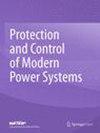Fault location of untransposed double-circuit transmission lines based on an improved Karrenbauer matrix and the QPSO algorithm
IF 11.9
1区 工程技术
Q1 ENERGY & FUELS
引用次数: 0
Abstract
Abstract Some double-circuit transmission lines are untransposed, which results in complex coupling relations between the parameters of the transmission lines. If the traditional modal transformation matrix is directly used to decouple the parameters, it can lead to large errors in the decoupled modal parameter, errors which will be amplified in the fault location equation. Consequently, it makes the fault location results of the untransposed double-circuit transmission lines less accurate. Therefore, a new modal transformation method is needed to decouple the parameter matrix of untransposed double-circuit transmission lines and realize the fault location according to the decoupled modal parameter. By improving the basis of the Karrenbauer matrix, a modal transformation matrix suitable for decoupling parameters of untransposed double-circuit transmission lines is obtained. To address the difficulties in solving the fault location equation of untransposed double-circuit transmission lines, a new fault location method based on an improved Karrenbauer matrix and the quantum-behaved particle swarm optimization (QPSO) algorithm is proposed. Firstly, the line parameter matrix is decomposed into identical and inverse sequence components using the identical-inverse sequence component transformation. The Karrenbauer matrix is then transformed to obtain the improved Karrenbauer matrix for untransposed double-circuit transmission lines and applied to identical and inverse sequence components to solve the decoupled modal parameter. Secondly, based on the principle that voltage magnitudes at both ends are equal, the fault location equation is expressed using sequence components at each end, and the QPSO algorithm is introduced to solve the equation. Finally, the feasibility and accuracy of the proposed method are verified by PSCAD simulation. The simulation results fully demonstrate that the innovative improvement on the basis of the traditional modal transformation matrix in this paper can realize the modal transformation of the complex coupling parameters of the untransposed double-circuit transmission lines. It causes almost no errors in the decoupling process. The QPSO algorithm can also solve the fault location equation more accurately. The new fault location method can realize the accurate fault location of untransposed double-circuit transmission lines.基于改进Karrenbauer矩阵和QPSO算法的非转置双回输电线路故障定位
摘要一些双回路传输线是未转置的,这导致传输线参数之间的耦合关系复杂。如果直接使用传统的模态变换矩阵对参数进行解耦,解耦后的模态参数会产生较大的误差,而这种误差在故障定位方程中会被放大。这使得未转置双回线的故障定位结果精度降低。因此,需要一种新的模态变换方法对未转置双回线的参数矩阵进行解耦,并根据解耦后的模态参数实现故障定位。通过改进卡伦鲍尔矩阵的基础,得到了适用于非转置双回线解耦参数的模态变换矩阵。针对非转置双回传输线故障定位方程求解困难的问题,提出了一种基于改进卡伦鲍尔矩阵和量子粒子群优化(QPSO)算法的故障定位新方法。首先,利用等逆序列分量变换将直线参数矩阵分解为等逆序列分量;然后对Karrenbauer矩阵进行变换,得到未转置双回路传输线的改进Karrenbauer矩阵,并将其应用于同序列分量和逆序列分量上求解解耦模态参数。其次,基于两端电压幅值相等的原理,利用两端的序列分量表示故障定位方程,并引入QPSO算法求解该方程;最后,通过PSCAD仿真验证了该方法的可行性和准确性。仿真结果充分表明,本文在传统模态变换矩阵基础上的创新改进,可以实现非转置双回路输电线路复杂耦合参数的模态变换。它在解耦过程中几乎不会产生误差。QPSO算法还可以更准确地求解故障定位方程。该方法可以实现非转置双回路输电线路的准确故障定位。
本文章由计算机程序翻译,如有差异,请以英文原文为准。
求助全文
约1分钟内获得全文
求助全文
来源期刊
CiteScore
20.10
自引率
8.20%
发文量
43
审稿时长
4 weeks
期刊介绍:
Protection and Control of Modern Power Systems (PCMP) is the first international modern power system protection and control journal originated in China. The journal is dedicated to presenting top-level academic achievements in this field and aims to provide a platform for international researchers and engineers, with a special focus on authors from China, to maximize the papers' impact worldwide and contribute to the development of the power industry. PCMP is sponsored by Xuchang Ketop Electrical Research Institute and is edited and published by Power System Protection and Control Press.
PCMP focuses on advanced views, techniques, methodologies, and experience in the field of protection and control of modern power systems to showcase the latest technological achievements. However, it is important to note that the journal will cease to be published by SpringerOpen as of 31 December 2023. Nonetheless, it will continue in cooperation with a new publisher.

 求助内容:
求助内容: 应助结果提醒方式:
应助结果提醒方式:


